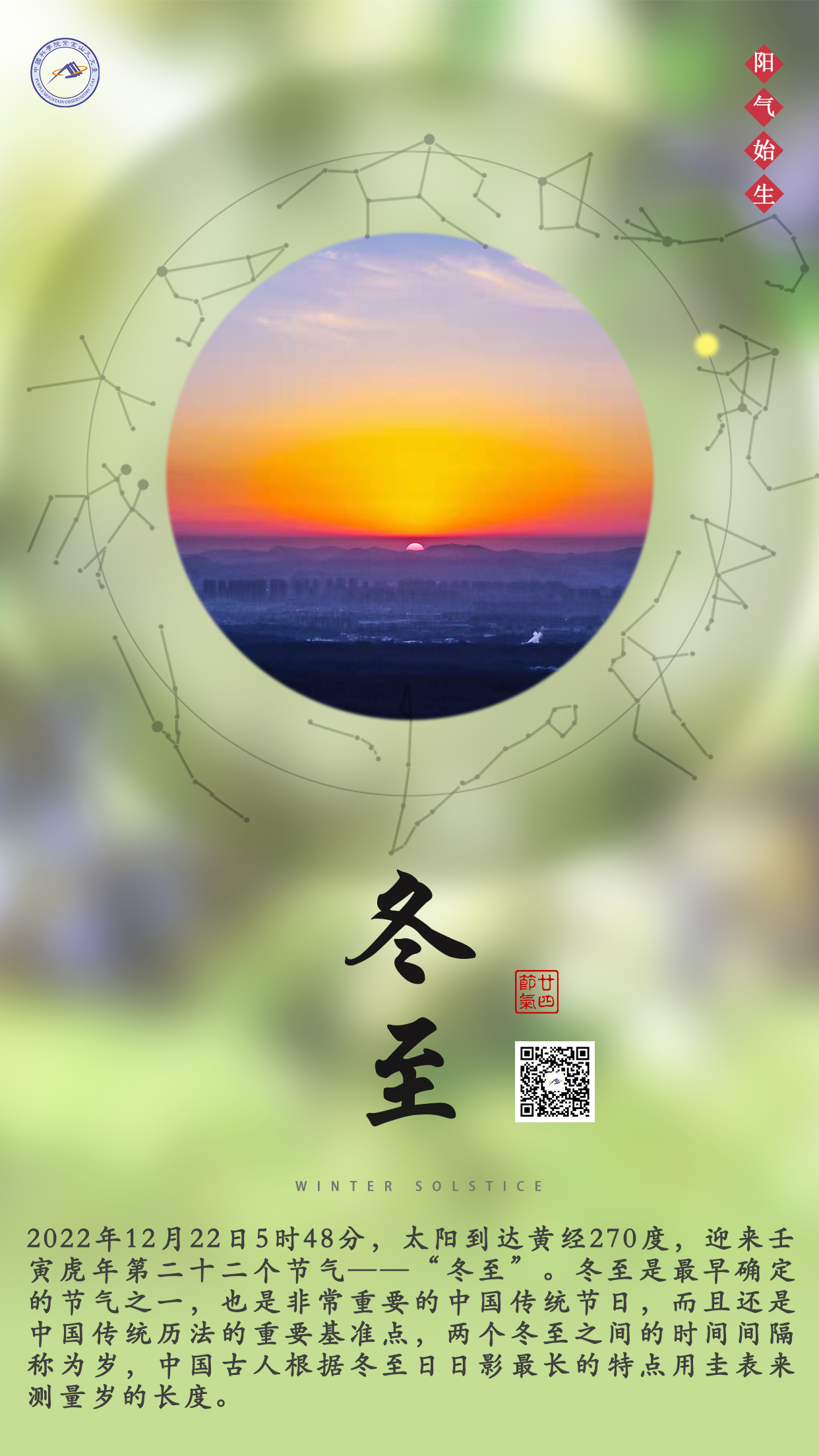“冬至日光白,始知阴气凝。”《中国天文年历》显示,北京时间12月22日5时48分迎来2022年“冬至”节气。

天象预报
**冬至——**小寒
太阳
在人马座运行。目前太阳活动性有所增强,太阳正面有数群黑子,可通过带减光的望远镜观测。1月5日0时17分,地球过轨道近日点,距离太阳0.983天文单位,太阳的视直径达到一年中最大值,为32′32″。
月亮
2023年1月4日凌晨3时37分,火星合月,地心所见火星在月球以北0.54度。3日晚,我国可见二者相伴出现在东方夜空,非洲、印度洋等地可见月掩火星。
水星
在人马座运行,12月29日,水星留,之后由顺行转为逆行。日落后可向西南方低空用望远镜尝试观测。
金星
从人马座顺行至摩羯座。12月29日,水星合金星,二者相距约1.4度,日落后可向西南方低空用望远镜尝试观测。
火星
在金牛座逆行。12月26日火星上迎来春分,太阳直射火星赤道,这一天也是火星的新年。日落后,明亮的火星高悬东方,整夜可见。目前仍是一年中观测条件最好的时期。
木星
在双鱼座顺行。12月22日木星东方照,位于太阳以东90度的位置,入夜后明亮的木星位于南方天空,前半夜可以观测。
土星
在摩羯座顺行。入夜后位于西南方天空,晚上9时左右落下。
流星雨
北京时间2023年1月4日11时,北半球三大流星雨之一的象限仪座流星进入极大,预计最大天顶每时出现率(ZHR)为110。辐射点在后半夜升起,但观测会受到月光的强烈影响。
小知识
“一九、二九不出手;三九、四九冰上走;五九、六九,沿河看柳;七九河开,八九雁来;九九加一九,耕牛遍地走。”这是在我国民间广为流传的数九歌。所谓数九即从冬至日算起,每9天为一个“九”,第一个9天为“一九”,第二个9天为“二九”,依此类推,第九个9天为“九九”,共计81天。冬至日是寒冬来临的标志,九九结束则在惊蛰和春分之间,此时已是春回大地。
民间流传的若干版本的数九歌都是在长期的生产和生活实践中总结出来的,形象生动地反映了寒冬到来至来年春季回暖期间的气候和物候变化过程。
冬至还是我国传统文化中非常重要的祭祀节日,有着“冬至大如年”的说法。自古就有冬至祭天祭祖的活动:帝王于郊外举行祭天大典,为天下苍生祈求风调雨顺、国泰民安;民间百姓则祭拜祖先,表达缅怀先人、不忘根本之情。
The Winter Solstice
The twenty-second solar term of 2022 , Winter Solstice (Dongzhi in Chinese), falls on December 22nd at 5:48, when the longitude of the Sun reaches 270º. As one of the earliest established solar terms, Winter Solstice is also an important traditional Chinese festivity and base point in traditional Chinese calendar. The period between two successive winter solstices is called “sui” (meaning one year in Chinese). According to the regularity that the sun casts the longest shadow on Winter Solstice, ancient Chinese measures the length of a year with a gnomon.
Astronomical Forecast
Winter Solstice——Minor Cold
⊙
The Sun
✦
The sun travels in Sagittarius. Currently, solar activities are increasing, with a few groups of sunspots on its surface. They can be observed through a telescope with a solar filter. On January 5th, 00:17, the earth is at perihelion, with earth-sun distance being 0.983 AU. The apparent diameter of the sun is 32'32'', the largest of the year.
☽
The Moon
✦
On January 4th, 03:37, Mars is at conjunction with the moon. Seen from the centre of the earth, Mars is at 0.54 º north to the moon. On the evening of January 3rd, Mars and moon will appear together in the eastern sky in China,while in Africa and Indian Ocean , lunar occultation of Mars can be observed.
☿
Mercury
✦
Mercury travels in Sagittarius. On December 29th, Mercury is stationary, after which it changes from prograde motion to retrograde motion. Mercury might be found after sunset in low south-eastern sky with a telescope.
♀
Venus
✦
Venus arrives Capricornus in prograde motion . On December 29th, it is at conjunction with Mercury, with a distance of 1.4º. After sunset, they might be found in the low sky through a telescope pointing south-west.
♂
Mars
✦
Mars travels in Taurus in retrograde motion. December 26th is the vernal equinox on Mars, when the sun shines directly above Mars' equator, which marks the new year's day of Mars. After sunset, Mars hangs high in the eastern sky , observable all night long. It is now the best time of the year to observe Mars.
♃
Jupiter
✦
Jupiter travels in prograde motion in Pisces. On December 22nd, the planet is at eastern quadrature. In the evening, a bright Jupiter appears in the southern sky and can be observed during the first half of the night.
♄
Saturn
✦
Saturn travels in prograde motion in Capricornus. It appears in the southwestern sky at nightfall and sets at 9 p.m.
Meteor Shower
✦
On January 4th ,11 a.m. one of the three major meteor showers in the northern hemisphere, the Quadrantids enters its active period. The estimated peak Zenithal Hourly Rate (ZHR) is 110. The radiant will rise after midnight; however, observation of the meteor shower will be severely affected by moon light.
轮值主编:张水乃
制作、编辑:王科超
英文版设计:朱曼清
(金陵中学)ZHU manqing






 扫码下载APP
扫码下载APP

 科普中国APP
科普中国APP
 科普中国
科普中国
 科普中国
科普中国